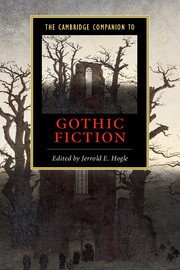Book contents
- Frontmatter
- 1 Introduction
- 2 The genesis of “Gothic” fiction
- 3 The 1790s
- 4 French and German Gothic
- 5 Gothic fictions and Romantic writing in Britain
- 6 Scottish and Irish Gothic
- 7 English Gothic theatre
- 8 The Victorian Gothic in English novels and stories, 1830-1880
- 9 The rise of American Gothic
- 10 British Gothic fiction, 1885-1930
- 11 The Gothic on screen
- 12 Colonial and postcolonial Gothic
- 13 The contemporary Gothic
- 14 Aftergothic
- Guide to further reading
- Filmography
- Index
- Series list
9 - The rise of American Gothic
Published online by Cambridge University Press: 28 May 2006
- Frontmatter
- 1 Introduction
- 2 The genesis of “Gothic” fiction
- 3 The 1790s
- 4 French and German Gothic
- 5 Gothic fictions and Romantic writing in Britain
- 6 Scottish and Irish Gothic
- 7 English Gothic theatre
- 8 The Victorian Gothic in English novels and stories, 1830-1880
- 9 The rise of American Gothic
- 10 British Gothic fiction, 1885-1930
- 11 The Gothic on screen
- 12 Colonial and postcolonial Gothic
- 13 The contemporary Gothic
- 14 Aftergothic
- Guide to further reading
- Filmography
- Index
- Series list
Summary
From the turn of the eighteenth into the nineteenth century and the beginnings of a distinctive American literature, the Gothic has stubbornly flourished in the United States. Its cultural role, though, has been entirely paradoxical: an optimistic country founded upon the Enlightenment principles of liberty and “the pursuit of happiness,” a country that supposedly repudiated the burden of history and its irrational claims, has produced a strain of literature that is haunted by an insistent, undead past and fascinated by the strange beauty of sorrow. How can the strikingly ironic, even perverse, career of the Gothic in America be accounted for? Why has it been so at home on such inhospitable ground?
The most common responses to these questions have recourse to conventional metaphors: the Gothic, it is frequently reasoned, embodies and gives voice to the dark nightmare that is the underside of “the American dream.” This formulation is true up to a point, for it reveals the limitations of American faith in social and material progress. Yet a simple opposition between the convenient figures of dream and nightmare is overly reductive. These clichés, and the impulses in American life that they represent, are not in mere opposition; they actually interfuse and interact with each other. This realization will take us far in understanding the odd centrality of Gothic cultural production in the United States, where the past constantly inhabits the present, where progress generates an almost unbearable anxiety about its costs, and where an insatiable appetite for spectacles of grotesque violence is part of the texture of everyday reality.
- Type
- Chapter
- Information
- The Cambridge Companion to Gothic Fiction , pp. 167 - 188Publisher: Cambridge University PressPrint publication year: 2002
- 46
- Cited by

